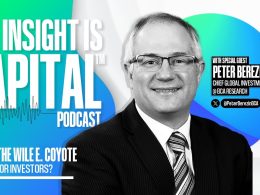Six key questions for December
by Kristina Hooper, Global Market Strategist, Invesco Ltd., Invesco Canada
The final month of 2017 has begun, and markets are facing a long list of unresolved issues that promise to shape the course of the new year. Here are six critical questions that I will be watching closely:
1. What will the U.S. tax reform bill ultimately look like?
In the wee hours of Saturday morning, the U.S. Senate passed its version of the tax reform bill. So many revisions were made in the hours leading up to the bill’s passage – and so many promises were made to secure certain senators’ votes – that we are still learning all that is in it. It will now likely head to a committee that can reconcile the two versions – House and Senate – of the bill.
The most important elements of the bill appear to be intact: the lowering of the corporate tax rate to 20% and the expensing of capital investment. These are the elements that I have long said are necessary to support the stock market at these elevated levels – and also should be a positive for economic growth over the longer term. And, if companies increase capital expenditures, I believe there is a strong possibility that productivity will improve significantly.
2. Will the U.S. government shut down?
With all the excitement over the U.S. tax reform bill, few have focused on the December 8 deadline for funding the government, but this is an important issue. It was reported last week that U.S. President Donald Trump was postulating that a government shutdown would work in his favour, as Democrats could be blamed.
However, U.S. Senate Majority Leader Mitch McConnell reassured the public this weekend that he didn’t expect there to be a government shutdown. But, unlike with the tax bill, getting enough votes to continue funding the government and to raise the debt ceiling will require Republicans to garner support from some Democrats. We will want to follow developments closely.
3. Will global economic strength help stocks?
Growth continues to positively surprise in many parts of the world, and data released last week supports that. For example, the final manufacturing Purchasing Managers’ Index (PMI) for the eurozone in November was 60.11, and the labour market for the 19 countries in the eurozone has improved significantly. In the month of October, unemployment was 8.8% for the group, down from 8.9% the previous month – and from 9.8% in October 2016.2
This is the lowest unemployment rate in years. In Japan, the manufacturing PMI was 53.6 in November, the best in several years.1 Some emerging-market countries are also experiencing significant growth. Brazil real gross domestic product (GDP) has continued its recovery, increasing 1.4% year over year for the third quarter.3
This is a very substantial improvement from just a few years ago. India real GDP also improved in the July–September quarter to 6.3% year over year.4 Global growth is one of two key drivers that I believe will create an upward bias for stocks in coming months.
4. What will happen with North Korea?
Last week saw North Korea launch an intercontinental ballistic missile (ICBM), which was able to fly higher and longer than previously seen before landing in the Sea of Japan. It is clear that North Korea is rapidly improving its missile capabilities – and that it can claim the ability to strike the United States with a nuclear weapon. This past weekend, U.S. Senator Lindsey Graham, R-S.C., said that time is running out to prepare for war.
He explained: “We’re getting close to a military conflict because North Korea is marching toward marrying up the technology of an ICBM with a nuclear weapon on top that can not only get to America, but deliver the weapon.” However, before military actions are considered, we must hope that the U.S. and its allies exercise the option of economic sanctions against North Korea – particularly with regard to China and Russia.
5. Will the Federal Reserve alter its policy?
Last week the White House announced the nomination of Marvin Goodfriend to be a Federal Reserve (Fed) governor. This suggests we could see a decidedly different Federal Open Market Committee next year, as Goodfriend has in the past been very critical of quantitative easing and has also advocated a more rules-based approach to monetary policy.
This suggests there may be a bigger rush in reducing the size of the Fed’s balance sheet – or, in general, a more hawkish tilt for the Fed, especially if there are more Fed nominees like Goodfriend. In short, Goodfriend’s nomination is likely to contribute to the environment of monetary-policy uncertainty we are currently in.
6. Can a Brexit agreement be reached?
Britain and the European Union appear to have made progress last week on the divorce bill. However, the border for Northern Ireland appears to be a source of disagreement. The stakes are getting higher, as British Prime Minister Theresa May is meeting Monday with European Commission President Jean-Claude Juncker.
The European Union continues to flex its muscles, with European Council President Donald Tusk saying that Juncker needs to be convinced ample progress has been made on this border issue before Brexit negotiations can continue. Time is of the essence, and there is little room for error.
In summary, December promises to be a very busy month – with significant implications for the economy and markets.
Subscribe to the Invesco Canada blog and get Kristina Hooper’s market reviews in your inbox.
This post was originally published at Invesco Canada Blog
Copyright © Invesco Canada Blog














